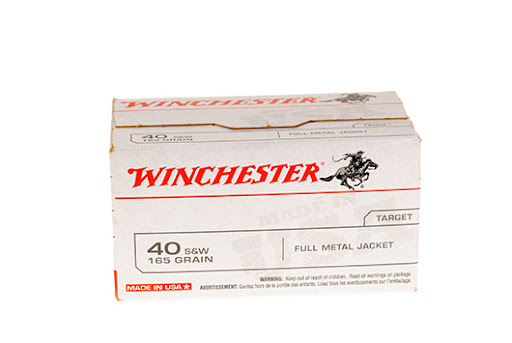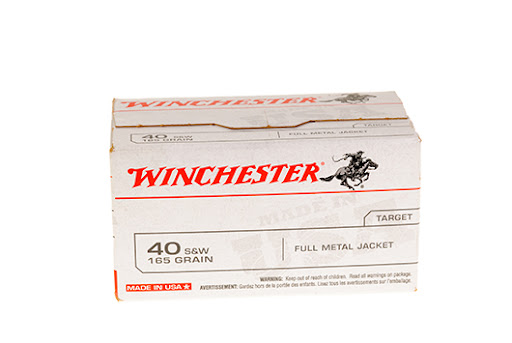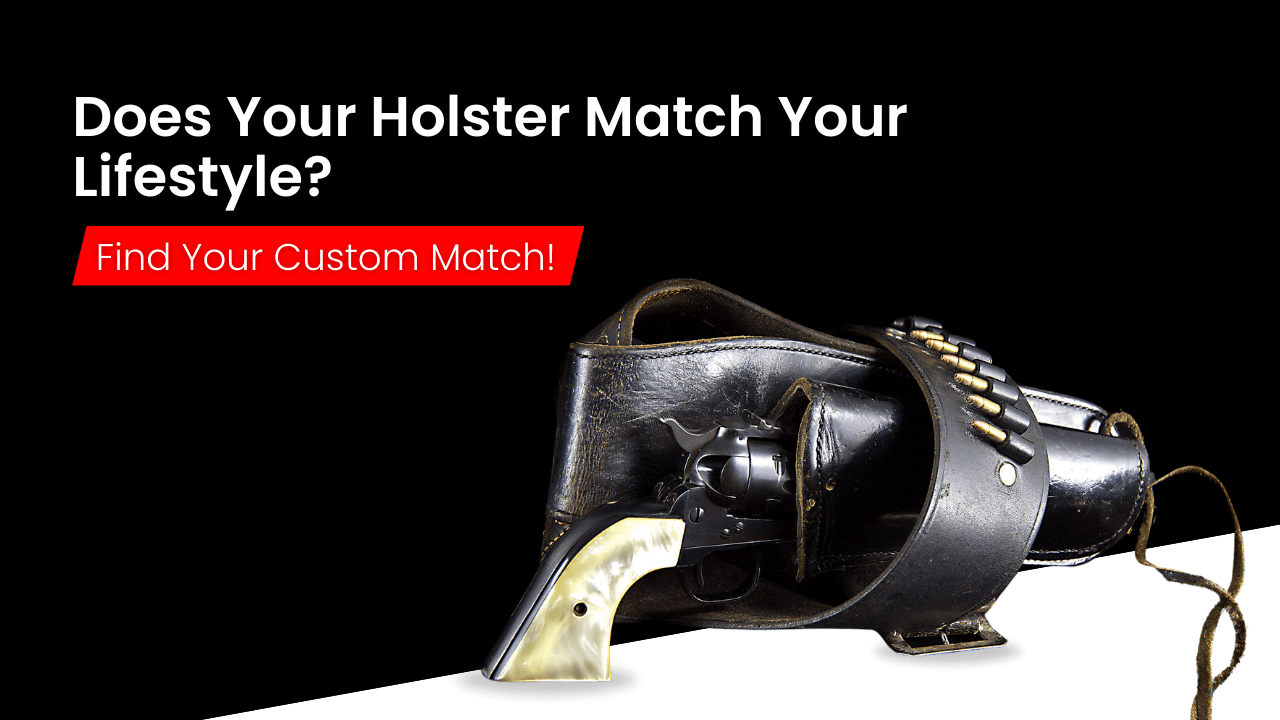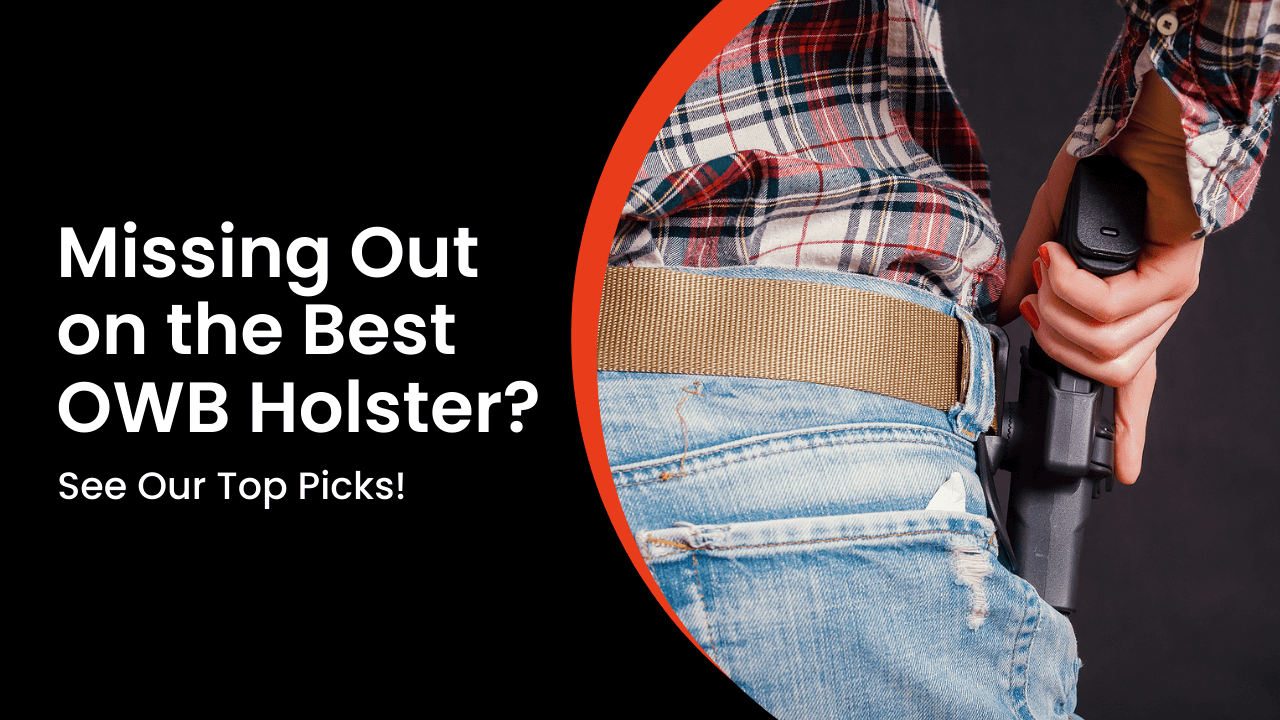What You Need to Know When Carrying a Glock 23 OWB
Mar 28th 2022
Millions of Americans routinely exercise their rights by carrying firearms for self-defense. The Glock 23, chambered in the .40 S&W cartridge, is a popular choice for concealed and open carry, home defense, and law enforcement service, providing a moderately heavy-caliber weapon roughly the same size and weight as the classic Glock 19.
As with any gun you intend to carry for personal protection, you need a high-quality carry holster that allows you to wear it safely and securely, draw smoothly, and protect the weapon.
The Glock 23
In 1990, Smith & Wesson, in cooperation with Winchester, developed the .40 S&W cartridge. The goal was to replicate the service ballistics of the FBI's 10mm Autoload in a reduced-length cartridge compatible with medium-framed handguns.
Glock delivered two pistols, the Glock 22 and 23, beating Smith & Wesson to the market. The Glock 22 is analogous to the G17 a full-size service handgun designed as a duty pistol. The Glock 23 is a compact variant and an excellent option for concealed carry.
Chambered in .40 S&W, the Glock 23 is fed from a 13-round, holding two fewer rounds compared with the G22. However, the G23 will also accept 14-, 15-, 16-, and 22-round magazines, providing you with several capacity options. The G23 is analogous to the G19 but firing a more powerful cartridge. The loaded weight is 31.22 oz. When you empty the magazine, the weight drops to 23.63 oz.
The G23 has a barrel length of 4.02”, as opposed to the G22's 4.49”, and an overall length of 7.36”. Its height, from the top of the rear sight to the base of the magazine, is 5.04”.
While there are various popular handguns on the market, such as Kimber, Ruger, SIG Sauer, and Heckler & Koch, Glock continues to remain the default due to its simple, cost-effective, and rugged design. The Glock series consists of polymer-framed, striker-fired semi-automatic pistols that use a short-recoil operation based on Browning's design. Using the Safe Action System, Glock firearms employ three different passive safeties.

The .40 S&W Cartridge
The .40 S&W cartridge is widely regarded among gun owners as bridging the gap between the 9mm and .45 ACP cartridges. While those who favor the 9mm prefer the higher magazine capacities and reduced recoil that the cartridge affords, .45-caliber enthusiasts champion the big-bore round's increased stopping power. The .40 S&W round provides a middle ground with more rounds than the .45, greater bullet weight and caliber than the 9mm, and generally higher muzzle energies than both.
IWB and OWB Holsters
There are many ways to carry a handgun, but waistband holsters are among the most popular. In the context of waistband holsters, there are two different methods of carrying: IWB and OWB.
IWB, or inside the waistband, involves wearing the holster between the waistband of your pants and your body. The holster attaches to the belt, or the clothing fabric, using belt clips. As part of the firearm remains below the beltline, IWB holsters allow for increased concealment relative to OWB.
In outside-the-waistband (OWB) carry, the holster is located outside and can't be as effectively hidden. However, OWB holsters are also often regarded as more comfortable because they aren't being compressed against the body by the waistband. If you decide to wear an OWB holster, you'll need to wear a cover garment, such as a jacket. During the warmer months, this can prove challenging.
Different Types of Holsters
Waistband holsters are among the most common types of holsters; however, there are other options. Although not appropriate for full-size and compact Glock handguns, some gun owners choose to wear an ankle holster. Generally worn on the inside of the non-dominant leg, the ankle holster allows you to carry a discreet backup weapon, such as a snub-nosed revolver.
Alternatively, there are shoulder holsters. Wearing a handgun under your non-dominant arm, the shoulder holster evokes images of the 1980s and ‘90s action films and detective dramas. While shoulder holsters do have practical value under certain circumstances e.g., for pregnant women, those who drive for prolonged periods, etc. they're slow to draw from, can cause you to muzzle people behind you, and require you to wear a jacket or coat.
If you're considering waistband holsters, a paddle holster is another option. Unlike the standard pancake holster design, the paddle holster allows you to attach and detach the weapon from your belt quickly. This can be highly useful for police detectives and undercover officers.
Holster Selection Criteria
When you purchase a holster, you want to know it will meet the highest form, fit, and function standards. After all, this piece of equipment will help or hinder your ability to defend your life.
Holster Materials
Gun holsters are typically made from one of three materials:
Leather
Leather is the traditional material for gun holsters, knife sheaths, and rifle slings. Vegetable-tanned cowhide or horsehide leather can be comfortable, beautifully crafted, reasonably durable, and stylish. A leather holster is a good option, depending on your environment and other factors.
However, for leather to be resistant to the elements, it must be chemically treated. Untreated leather can absorb water, deforming in the process. While aged leather can develop an attractive patina, it can also wear over time, losing retention. Soft leather is a potential liability, especially if the material can enter the trigger guard. As a result, while leather holsters are still popular for all-weather equipment, other materials have their advantages.
Nylon
Depending on the denier ratings, Nylon fabrics are often less expensive than leather and Kydex holsters. As nylon holsters are not custom-molded or thermoformed to a particular firearm, they tend to be more universally applicable. Nylon holsters are also among the quietest to draw from and won't scratch your gun's finish. However, nylon holsters usually require a thumb break or strap for retention and don't provide the same structural support. As a result, holsters made from this material are among the worst available.
Kydex
Kydex, an acrylic PVC thermoplastic, was developed in the 1960s for use in the aircraft industry. Since then, it's been used extensively in the production of knife sheaths and gun holsters. Kydex provides a durable, weather-resistant, and perfect fit for your concealed- or open-carry firearm. The thermoforming process also provides excellent retention. As it's inherently waterproof, Kydex can withstand submersion in water, rain, snow, and muddy conditions.
Easy to clean and low maintenance, Kydex is suitable for many defensive and sporting purposes, which explains its popularity among private citizens, law-enforcement officers, and military personnel alike.
While some find the audible click to be useful feedback, drawing and reholstering firearms is noisier with Kydex than most other materials. Kydex can also accelerate holster wear.
The Importance of Retention
The primary function of a holster is to hold your weapon securely, so it doesn't fall as you move throughout the day. The secondary purpose of a holster is to position the weapon, so it's accessible when you need it.
Kydex holsters are unique relative to other designs due to their thermoformed construction. As the Kydex holster is molded to fit a particular firearm, it can passively retain the weapon more effectively than competing materials or designs. Kydex holsters often provide adjustable retention using screws. Kydex is available in a wide range of colors, so there's a holster that every user will love.
A Good Holster Should be Tough
Durability matters in a concealed carry holster; it's what allows you to use your holster for years, regardless of the environment. While a holster can protect your firearm from the elements, it should also maintain its structural integrity, resisting deformation. As a result, the best concealed carry holsters on the market today are rigid and can hold their own against various adverse conditions.
Comfort Matters
A holster should be comfortable to wear, which is why it's essential to experiment with different carry methods and positions, including ride height and cant. Carry angle (cant) alone can have a serious effect on both comfort and concealment. If your holster isn't comfortable to wear, you're more likely to leave your gun at home or in your vehicle's glove compartment. Your holster shouldn't be a burden but a faithful companion.
While Kydex isn't one of the most comfortable holster materials, it is less likely to stick to wet skin in the warmer months due to its rigidity. Fortunately, Kydex holsters are available in various styles to suit any shooter.
Holster Safety
Any holster you decide to wear should cover the trigger guard. Gun safety will always be the shooter's responsibility, but safety isn't strictly about trigger discipline. You don't want an assailant to place his finger on the trigger of your firearm as it's sitting in its holster.
Protecting Against Perspiration
Sweat is corrosive and can damage a firearm's finish. Your Glock handgun has a protective finish, but you should aim to protect it further. A sweat shield should act as a barrier between your body and your gun; however, it shouldn't limit your ability to acquire a full firing grip. That means your middle finger is high on the front strap, contacting the trigger guard and webbing against the beavertail.
Magazine Carriers
The Glock 23 has a relatively high magazine capacity. You may decide, as a result, that carrying spare ammunition isn't strictly necessary because thirteen rounds (plus one round in the chamber) should be sufficient for most defensive shootings.
While that's generally true, you can never predict how many rounds you'll need to defend yourself effectively. Magazine pouches are great accessories, allowing you to carry extra ammunition for your weapon and ensuring that you're prepared for anything.
What's the Best Position for Concealed Carry?
In waistband holsters, the best position for concealed carry is a controversial topic. Each carry position has its pros and cons, and you'll need to try a few different positions, varying your ride height and cant, to find the position that best suits you.
The most popular waistband positions are:
Strong Side
Your strong side is your dominant side. In strong-side carry, you place the holster on or behind the hip that corresponds to your dominant hand. If you're right-handed, you'll carry on your right hip. Using clock-face hour-hand positions for reference, your holster will be at 3–5 o'clock if you're right-handed and 7–9 o'clock if you're left-handed.
Strong-side carry allows you to place your hand on your weapon discreetly in anticipation of an assault by blading your support side toward the threat. You're also able to use your support hand to maintain distance between the assailant and your weapon. However, strong-side carry does not allow for a convenient draw when seated in a vehicle. Navigating seat belts can also be a chore.
Appendix
Placing the weapon between 11 and 2 o'clock, with 12 and 1 o'clock being the most common positions, appendix carry offers a few advantages relative to strong side. The first is accessibility because the weapon is in the front of your pants. The second is that some shooters find appendix carry improves concealment, as you're able to drape a layer of fabric over the weapon, making it easier to avoid printing. However, you need to ensure you are cautious during the reholstering process, as the gun's muzzle is pointed in a very intimate direction.
Final Thoughts
The Glock 23 is a reliable, effective, rugged weapon, delivering .40-caliber power in a package the same size and unloaded weight as the Glock 19. Introduced two years after the G19, the G23 has proven itself a popular weapon with gun owners.
Incognito Concealment offers various holster options to take full advantage of the G23's capabilities, each built to last and molded to perfection in the USA. All of our holsters and other products come with a lifetime warranty. Give us a call, and we'll help you decide which holster you need for your weapon and circumstances.
FAQs
Will a Glock 19 holster fit a Glock 23?
Yes. The Glock 23 and Glock 19 pistols are identical regarding height, width, overall length, and empty weight.
Can you carry a Glock 23 concealed?
Like the Glock 19, the G23 is highly suitable for concealed carry because it is relatively compact and lightweight.











